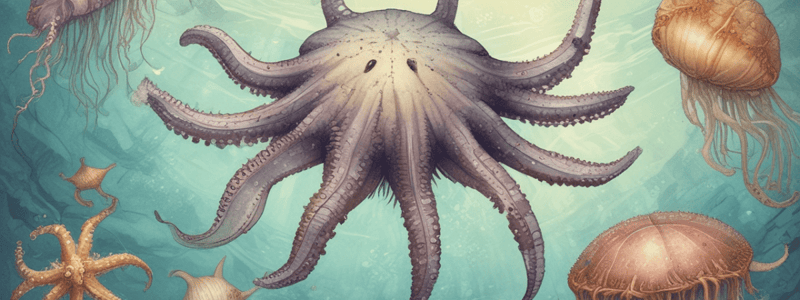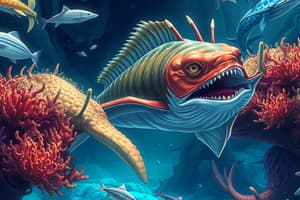Podcast
Questions and Answers
Which phylum does the sea anemone Actinia equina belong to?
Which phylum does the sea anemone Actinia equina belong to?
- Phylum Arthropoda
- Phylum Echinodermata
- Phylum Cnidaria (correct)
- Phylum Mollusca
Which class does the Canadian snail Cepaea nemoralis belong to?
Which class does the Canadian snail Cepaea nemoralis belong to?
- Gastropods (correct)
- Crustaceans
- Cephalopods
- Bivalves
Which animal belongs to the Phylum Echinodermata?
Which animal belongs to the Phylum Echinodermata?
- House centipede
- Striped Bark Scorpion
- Red-knobbed sea star (correct)
- Eudicella smithii
Which animal belongs to the class Cephalopods?
Which animal belongs to the class Cephalopods?
Which phylum does the Striped Bark Scorpion belong to?
Which phylum does the Striped Bark Scorpion belong to?
Which animal belongs to the class Myriapods?
Which animal belongs to the class Myriapods?
Which animal belongs to the class Bivalves?
Which animal belongs to the class Bivalves?
Which animal belongs to the class Gastropods?
Which animal belongs to the class Gastropods?
Which animal belongs to the Phylum Echinodermata?
Which animal belongs to the Phylum Echinodermata?
Which animal belongs to the class Cephalopods?
Which animal belongs to the class Cephalopods?
Flashcards are hidden until you start studying
Study Notes
Kingdom Animalia
- Composed of multicellular, heterotrophic organisms whose cells do not have cell walls.
- Organisms that cannot make their own food and must eat other living things to stay alive.
Vertebrates and Invertebrates
- Vertebrates have a backbone or spinal column (vertebral column).
- Examples of vertebrates: fish, amphibians, reptiles, birds, and mammals.
- Invertebrates do not have a backbone or vertebral column.
- Over 90% of all animals on Earth are invertebrates.
Invertebrates
- Subdivided into almost 30 different phyla.
- First type of animal to evolve.
- Over 1.3 million different species.
Phylum Porifera
- Contains the organisms commonly known as sponges.
- Sponges are predominantly sessile, meaning they are immobile.
- Sponges are filter-feeders.
Phylum Coelenterata (Cnidaria)
- Contains "stinging organisms" with specialized stinging cells called cnidocytes.
- Examples: jellyfish, corals, sea anemone, and microscopic organisms known as hydra.
- Coelenterates have a simple gastro-vascular system.
Phylum Ctenophora
- Contains the comb jellies.
- Comb jellies use beautiful comb-like cilia to swim and move.
- They look very similar to jellyfish, but do not have cnidocytes.
Phylum Platyhelminthes
- Contains the flatworms.
- Flatworms were the first to display bilateral symmetry.
- They have a central nervous system and a very small and simple "brain".
- Examples: Planaria, which can regenerate.
Phylum Nemertea
- Contains the ribbon worms.
- Ribbon worms are often round and very thin.
- They can eject a long, sticky, highly-branched proboscis from their head.
Phylum Rotifera
- Contains microscopic aquatic organisms.
- Rotifers get their name from a circle of cilia surrounding their mouths.
- They are usually only 50 µm to 2 mm long.
Phylum Gastrotricha
- Consists of another type of worm-like, microscopic animals.
- Gastrotichs are aquatic, and some live in fresh water and others are marine.
Other Phyla
- Phylum Nematomorpha: contains horsehair worms or hairsnakes.
- Phylum Nematoda: contains the roundworms.
- Phylum Acanthocephala: contains parasitic spiny-headed worms.
- Phylum Bryozoa: contains animals that resemble clumps of moss.
- Phylum Tardigrada: contains microscopic water bears.
- Phylum Brachiopoda: contains species with a unique structure called a lophophore.
- Phylum Mollusca: contains mollusks, with a soft, squishy body called a visceral mass.
- Phylum Annelida: contains segmented worms.
- Phylum Sipunculoidea: contains peanut worms.
- Phylum Chaetognatha: contains arrow worms.
- Phylum Echinodermata: contains sea stars, sea urchins, and sea cucumbers.
- Phylum Hemichordata: contains acorn worms.
- Phylum Arthropoda: contains arachnids, insects, and crustaceans.
Examples of Invertebrates
- Worms: flatworms, ribbon worms, horsehair worms, etc.
- Sponges: yellow tube sponge, purple vase sponge, etc.
- Cnidarians: Lion's Mane Jellyfish, brain coral, sea anemone, etc.
- Echinoderms: red-knobbed sea star, sand dollar, purple sea urchin, etc.
- Mollusks: snails, slugs, clams, oysters, octopuses, squids, etc.
- Arthropods: crabs, lobsters, shrimp, crawfish, pillbugs, spiders, scorpions, ticks, etc.
Studying That Suits You
Use AI to generate personalized quizzes and flashcards to suit your learning preferences.




